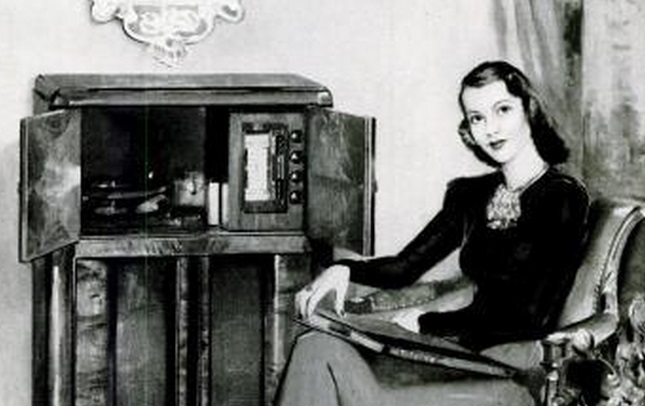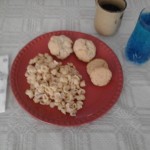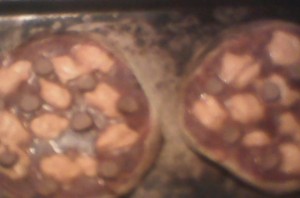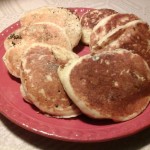The following Facebook post appeared today, and it’s the kind of testimonial that encouraged us to join Samaritan Ministries. You can read about our experience with this alternative to Obamacare at my earlier post.

The following Facebook post appeared today, and it’s the kind of testimonial that encouraged us to join Samaritan Ministries. You can read about our experience with this alternative to Obamacare at my earlier post.
 This RCA ad appeared in Life Magazine 75 years ago, January 22, 1940. It shows opera singer and RCA recording artist Lily Pons listening to her RCA Victrola Model U-42 radio-phonograph. Thishandsome console contained 8 tubes, and tuned both standard broadcast and short wave. The record changer was automatic, and the receiver feathured pushbutton tuning and a 6U5 “tuning eye.”
This RCA ad appeared in Life Magazine 75 years ago, January 22, 1940. It shows opera singer and RCA recording artist Lily Pons listening to her RCA Victrola Model U-42 radio-phonograph. Thishandsome console contained 8 tubes, and tuned both standard broadcast and short wave. The record changer was automatic, and the receiver feathured pushbutton tuning and a 6U5 “tuning eye.”
The schematic for this receiver is available at Nostalgiaair.
Click Here For Today’s Ripley’s Believe It Or Not Cartoon
![]()
For breakfast this morning, I departed somewhat from my previous shopping list. Instead of using the groceries I purchased this weekend, I had some oatmeal. Oatmeal is a good storage item, and it’s certainly within my budget, so I don’t consider this to be “cheating.” The particular oatmeal I ate was Quaker Pumpkin Spice Instant Oatmeal
. I had it in the house, and had actually purchased the 8 pack about a month ago at WalMart as a closeout item for only 25 cents. So my total expenditure for the two envelopes as 6-1/4 cents.
But since I didn’t buy the oatmeal during the SNAP Challenge period, it’s not fair to use 25 cents as the price. Instead, I’ll treat it as an expenditure of $1, since oatmeal (both instant and regular) is always available at the Dollar Store. Therefore, my total expenditures are now up to $27.99.
For lunch, I finished the chili from yesterday.
For supper, I used the tortillas and can of refried beans for burritos. I made seven, four of which I saved for later. After viewing my unusual looking food, my wife took pity on me and prepared the burritos. I could have done it, but they wouldn’t have looked nearly this good. As you can see, I finished up the blue Kool-Aid and am now working on the pink Kool-Aid.
The canned beans and prepared tortillas are certainly suitable items for medium-term storage, since the tortillas had an expiration date a few months away. So they’re both good items to keep around the house. But for long-term storage, there are even better options.
First of all, normal dry beans are cheap and will keep basically forever if properly stored. The disadvantage, of course, is that they require a fair amount of preparation and actual cooking. Another excellent option is the Honeyville refried bean flakes. These are dehydrated refried beans. You simply add hot water, and the result is refried beans which are indistinguishable from (or even better than) the canned variety. The cost is basically comprable to canned beans.
While tortillas will last a long time, the basic ingredient for corn tortillas, Maseca, will last basically forever if stored properly. The only other ingredient necessary to make tortillas is water, so this is a good choice for emergency food storage. It should be available in most Supermarkets, including WalMart.
Of course, one must know how to make tortillas. It’s not particularly difficult, but it does require some practice. And it’s made much easier by having the proper tool, namely a tortilla press such as the one shown here. They’re available at Amazon
, WalMart
, and many other places. If you can’t find one locally, you can order at WalMart online and pick it up at your local store.
Click Here For Today’s Ripley’s Believe It Or Not Cartoon
![]()
I have to admit that this year’s SNAP Challenge is proving to be a bit more challenging than last year, since I’m relying this year on food that is suitable for long-term storage (or, to put it another way, the so-called “non-perishable” items that people are asked to donate to food banks). My menu is about the same as last year, but I don’t have any bread, hot dogs, sausage, or hamburger. The overall cost is about the same, but the substitutes aren’t quite as good. In particular, the canned meat is starting to get old.
For breakfast this morning, I had pancakes and some of the Armour Treet. For lunch and supper, I made chili, using some of the Treet, one can of Chili beans, and one can of tomatoes. I’ve been grazing on the peanut butter cookies, so I made another batch. (I forgot to flatten them with a fork, but they taste OK.) Both are shown above.
I had one biscuit for lunch, but I’m starting to tire of them, so I had cookies with my chili for supper.
Click Here For Today’s Ripley’s Believe It Or Not Cartoon
![]()
Day 2 of the SNAP Challenge was again uneventful. I’m subsisting this week on less than $31.50 in groceries, and I’m concentrating on items that are easily storable.
After my initial failure with pancake syrup, I tried again last night and was somewhat more successful. Since I don’t have any brown sugar to work with, I used two parts sugar and one part water and let it simmer until it was the right consistency. Last year, my syrup was too watery, so I tried simmering it longer, taking care not to set off the smoke alarm as happened a couple of nights ago. I still don’t have the knack, since it was excessively crystallized. But I managed to get enough for my pancakes this morning, and for a couple more meals.
For lunch, I finished the tuna salad from yesterday, and had a couple of biscuits.
Supper consisted of the experimental pigs in blankets shown above. I simply made the biscuit dough, wrapped it around the remaining Vienna Sausages, and baked for about 15 minutes. I also made one package of the Ramen noodles. I washed it down with windshield washer fluid–er, I mean blue Kool-Aid.
With the exception of a couple of pats of margarine that I put on the pancakes, everything I consumed today is suitable for long-term storage.
Click Here For Today’s Ripley’s Believe It Or Not Cartoon
![]()
The SNAP Challenge got to an uneventful start today. For breakfast this morning, I had two of the pancakes. Because of the failure with the syrup last night, I put peanut butter on them. On the way to church, I put an extra pancake and a couple of cookies in my pocket, which I had as a snack on the way home.
 For a fast lunch, I made some tuna salad, consisting of pasta
For a fast lunch, I made some tuna salad, consisting of pasta, one can of tuna, and some mayonnaise
. I had about half of it for lunch and saved the rest for later. I also had two biscuits and a couple of cookies for dessert. I didn’t resort to drinking windshield washer fluid. The blue liquid was actually Kool-Aid, since it turns out that the first batch was that color, undoubtedly with all-natural coloring. I also had coffee. For some reason, many SNAP Challenge participants add to the suffering by erroneously concluding that coffee is out of their budget. I have plenty for a week, and it cost only about $2. I am conserving somewhat, however. Normally, I would go through the 10.5 ounce can in a little less than a week. Therefore, I’m making it one cup at a time, and I should have plenty for the week.
For supper, I made experimental pizza. Since one focus during my SNAP Challenge is the use of food appropriate for emergency storage, I decided to work with cheese. Storing dairy products can be a challenge for some, but there are many options. One of them is canned cheese, such as shown here. At WalMart, it cost about $2.50 for a 15-ounce can. It’s available in many supermarkets in the Mexican aisle. This one is called “condensed,” and for use in things like nachos, the instructions call for water to be added. We normally buy the uncondensed version, which sells for about $2 for the same size. It was out of stock when I made my shopping trip.
I used this cheese in pizzas, which are shown here.  As you can see, they wound up looking a bit unusual, since the cheese didn’t completely melt. Chances are a more skilled chef would be able to make the pizza look a bit more presentable, but it tasted good. The crusts are flour tortillas which I first coated with a bit of vegetable oil. On top of that was some of the spaghetti sauce. For toppings, I used about 1/4 of the can of cheese and two Vienna sausages.
As you can see, they wound up looking a bit unusual, since the cheese didn’t completely melt. Chances are a more skilled chef would be able to make the pizza look a bit more presentable, but it tasted good. The crusts are flour tortillas which I first coated with a bit of vegetable oil. On top of that was some of the spaghetti sauce. For toppings, I used about 1/4 of the can of cheese and two Vienna sausages.
Despite it’s odd looks, this year’s pizza tasted much better than my first attempt last year. Last year, I used plain tomato sauce, and I didn’t have many seasonings to work with. As a result, it was rather bland. In fact, the pizza represented the one time that I threw away leftovers last year. In addition, the canned cheese I used this year actually worked a lot better than the cheap cheese I used last year. And ounce for ounce, the price was about the same. I’ll be using the canned cheese in other recipes over the next few days. Even though the can of cheese represented my single largest expenditure this year, I think it was a good choice.
The can of cheese had an expiration date of May 2016, meaning that it has a shelf life of over a year. It does look like a good option for emergency storage. Calorie for calorie, it’s more expensive than other options (about $2.50 for 700 calories), but it’s still a good choice for adding a bit of variety.
I washed down supper with another glass of blue Kool-Aid and, of course, coffee.
Click Here For Today’s Ripley’s Believe It Or Not Cartoon
![]()
Seventy-five years ago, Gimbels Department Store in Milwaukee ran this ad for Emerson radios in the January 19, 1940 edition of the Milwaukee Journal.
For $9.95, you could get the standard broadcast receiver with a “miracle tone chamber” and built-in loop antenna. It came with a “safety power cord,” which apparently meant that it didn’t have a “curtain burner” cord with built-in dropping resistor for the filaments. This appears to be the Emerson Model 330 in a bakelite case. You can see the radio in operation at this YouTube video. Another nice example, along with the schematic, can be found at RadioMuseum.org or at N9DD’s site.
$19.95 would get you a six-tube set that tuned police calls as well as the 49-meter shortwave band. It appears to have two bands, meaning that the police calls were probably at the top end of the standard broadcast band.
And for $29.95, you could get the seven-tube set which also covered the broadcast and shortwave bands for “complete foreign and American Broadcasts” with “EXCELLENT tone.” This one appears to be similar to the Emerson Model 356, but with a slightly different cabinet. A nice video of a restored model in operation can be found at YouTube.
Click Here For Today’s Ripley’s Believe It Or Not Cartoon
![]()
I plan to start the seven-day SNAP challenge tomorrow. I did the shopping yesterday. I spent a total of $26.99 on groceries that should last me the week. Most people who take the SNAP challenge seem to go hungry since they don’t think about their basic caloric needs, which for most people is in the ballpark of 2000 calories per day.
Most of my caloric needs are taken care of with $4.94 of my purchase money, in the form of the following, which make up a total of 17,510 calories, more than enough for seven days: Five pounds of flour , four pounds of sugar
, and 16 ounces of cooking oil
. Those items are not, by themselves, particularly edible. Therefore, my mission for today was to change some of those ingredients, along with a few others, into actual food. Since this process takes about the same amount of time regardless of the quantity, I made enough for the next few days and put them in the freezer.
 I started by making the pancakes shown here. They are now in the freezer and can quickly be warmed up in the toaster or microwave for a fast breakfast or snack. I used the same recipe as last year, except I used cooking oil instead of margarine, in keeping with my theme this year of using ingredients that can be stored for emergency use.
I started by making the pancakes shown here. They are now in the freezer and can quickly be warmed up in the toaster or microwave for a fast breakfast or snack. I used the same recipe as last year, except I used cooking oil instead of margarine, in keeping with my theme this year of using ingredients that can be stored for emergency use.
And since my use of storage food items precludes the luxury of  having bread, I’ll be relying more on the pancakes and biscuits. I also made my first batch of biscuits, which are shown here. I again used the same recipe as last year, but used cooking oil in place of the sausage grease or margarine that I used previously.
having bread, I’ll be relying more on the pancakes and biscuits. I also made my first batch of biscuits, which are shown here. I again used the same recipe as last year, but used cooking oil in place of the sausage grease or margarine that I used previously.
I also made a batch of peanut butter cookies. The downfall of many SNAP challenge participants seems to be the lack of snack items. The 18 cookies I baked should tide me over between meals for the next couple of days. I used the same recipe as last year, but since I had more peanut butter to work with this year, I was slightly more generous. I went ahead and used the margarine for these cookies, although I think the cooking oil would have worked just as well.
I also prepared two other items, or at least tried to do so. Envelopes of Kool-Aid cost 20 cents, considerably less than the pre-sweetened variety. It’s easier to prepare it by the glass, so I made my own pre-sweetened Kool-Aid by adding one envelope to a cup of sugar. My first failure so far was with pancake syrup. I mixed two parts sugar and one part water (equal parts of white and brown sugar work better, but I don’t have brown sugar) and left them to simmer on the stove. I was reminded of this when the smoke detector went off, since I neglected to keep an eye on it. Perhaps I’ll try again tonight, but I’ll probably just clean up the mess and leave my syrup making for another day. In any event, I lost one cup of sugar, which was burnt to a crisp rather than delivering any food value. But last year, I had more than a pound of sugar left at the end of the SNAP challenge, so I won’t go hungry as a result of my carelessness.
Click Here For Today’s Ripley’s Believe It Or Not Cartoon
![]()
As I did in 2013, I will once again be taking the SNAP Challenge, starting in the next couple of days. I explained it in more detail when I originally took it, but the general idea is to subsist for seven days on $31.50 in food, which represents the average amount received by recipients of the SNAP program, formerly known as Food Stamps.
There seem to be two categories of people who take the challenge. The first group is made up of those who view the challenge as being extraordinarily trivial. Occasionally, one of them will announce that he or she is participating and go out and buy $31.50 worth of food. They often put little thought into what they buy, and they usually aren’t heard of after a few days. This is probably due to the fact that they failed.
The other group of people usually make it through the full seven days, but only after enduring a great deal of suffering. Like the other group, they usually make poor buying decisions by buying apparently “healthy” but expensive food. They usually suffer through the seven days, but are hungry most of the time.
I’m in the middle group. Last year, I discovered that the challenge was not trivial. But I also discovered that with a little bit of planning, I could eat quite well over the course of the seven days. This year, I’m doing it again, but with a new twist. One of the focuses of this blog is emergency preparedness, and I learned last year that the challenge also taught lessons for disaster planning.
On my website, I have a number of pages discussing emergency food storage. Since I don’t own any camouflage clothing, I’m not much of a “survivalist.” But even for those who are not contemplating a complete apocalypse, I believe that it is important to make preparations to be reasonably self-sufficient in emergencies. And having a reasonable amount of food in the house is one important preparation. In most cases, this “emergency food” is just part of the groceries we would normally buy. Therefore, the SNAP challenge is a good way to test these emergency supplies. Last year, my SNAP purchases included quite a few refrigerated items, such as hot dogs and ground beef. These would not be a good choice for emergency storage. This year, I made a point to store items that are similar to the kinds of things that can be stored for an emergency.
This is not a perfect test, because I also needed to stay under the $31.50 budget. Some of the storage food I would normally buy comes in larger quantities. Therefore, I have made a few substitutions:
I did buy six fresh eggs, which should stay in the refrigerator (although it’s relatively safe to store eggs at room temperature for a few days). For emergency storage, I would recommend Honeyville powdered eggs. Despite any bad reputation that powdered eggs might have, the Honeyville eggs are actually excellent, and indistinguishable from fresh eggs in cooking or baking. They can even be used for scrambled eggs, which taste almost as good as normal eggs. In a real emergency, I would use the Honeyville eggs. But for purposes of this test, they would be out of my budget. A large can costs almost $20. While they are economical, the can is much more than I need for one week. Therefore, I’m substituting fresh eggs, which cost me $1 for a half dozen.
I also purchased a pound of margarine. Margarine will keep outside of the refrigerator, but not for long-term use. In an actual emergency, there are other options. One option is canned butter (ghee), which is fairly expensive. Another more economical option is Honeyville Powdered Butter, which I have not actually tried, but seems to have excellent reviews. Another surprisingly good option is Butter Flavor Crisco
, which can be stored. Last year, I didn’t purchase any cooking oil. This time, to help allay any concerns that I’m “cheating”, I did purchase vegetable oil, which I’ll use for most cooking. Therefore, my use of the margarine should be farily minimal.
My shopping list for the challenge does include a couple of items that have fairly long shelf lives, but not what one might consider “long term.” I have one package of tortillas, and one bag of tortilla chips. Both of these have an expiration date a few months out, so it’s not unreasonable to believe that they would be in a normal cupboard in time of emergency.
Finally, as I did last year, the main staple of my diet will be my five-pound bag of self-rising flour. The bag I just purchased has an expiration date of December 2015, meaning that it can be stored for almost a year. For actual emergency storage, I would recommend normal flour, since the “self-rising” flour is nothing more than normal flour with baking powder already added. But for the SNAP challenge, the self-rising flour is easier on the budget. The smallest can of baking powder, which would last months, was over a dollar. For emergency use, it would be better to purchase regular flour along with a can or two of baking powder.
My focus on shelf-stable food means two big changes from last year’s challenge. First of all, I used two pounds of bread last year, and I don’t have the same luxury this year. But I had flour left over last year, so I’ll need to use the flour to make a substitute. Last year, I did have meat, in the form of hamburger, hot dogs, and sausages. This year, I’ll need to get by on canned meats. That will make things more challenging.
Finally, I should say a word about milk. I’ll be using shelf-stable milk. It’s always available at the dollar store for a dollar a quart, it has a shelf life of about a year, and it tastes just like any other milk. It’s a good choice for emergency storage, although since most of my uses are for cooking, powdered milk would be adequate. More information is available on my milk page.
As I did last year, I’ll spend a few hours the day before the challenge begins preparing some food. I’ll eat well during my week, but it does require advance preparation. And it’s more efficient to do most of the preparation all at once.
Today, I purchased the food shown above. My total expenditure was $26.99. I bought all of the food at either Walmart or Dollar Tree. The complete shopping list is shown below, along with the prices I paid. You can click on the links to see the exact items I purchased. (In a few cases, I couldn’t find the same brand online, in which case the link goes to an identical product of a different brand or size.)
Click Here For Today’s Ripley’s Believe It Or Not Cartoon
![]()
Ninety years ago, DeWolf Barton discovered the secret of attracting the girls: Just offer them the chance to go out for a spin on the ice of Lake Placid aboard his ice yacht. Barton, shown to the left piloting the craft, is joined by Virginia Markel of Cambridge, Mass., Dorothy Knoepke of South Orange, N.J., Patricia Schmidt of New York City, and Eloise Thompson of New Haven.
The radio is said to be a superhetrodyne fed by a “concealed loop” for an antenna. Mr. Barton was apparently a particularly skilled navigator of the craft, since there’s no mention of the boom of the sail knocking over the precariously placed speaker. This photo appeared in the January 17, 1925, issue of Radio World.
 Miss Markel was apparently no stranger to winter sports. She is shown here skiing at Lake Placid, from the December 27, 1928, issue of the Niagara Falls Gazette.
Miss Markel was apparently no stranger to winter sports. She is shown here skiing at Lake Placid, from the December 27, 1928, issue of the Niagara Falls Gazette.
Click Here For Today’s Ripley’s Believe It Or Not Cartoon
![]()